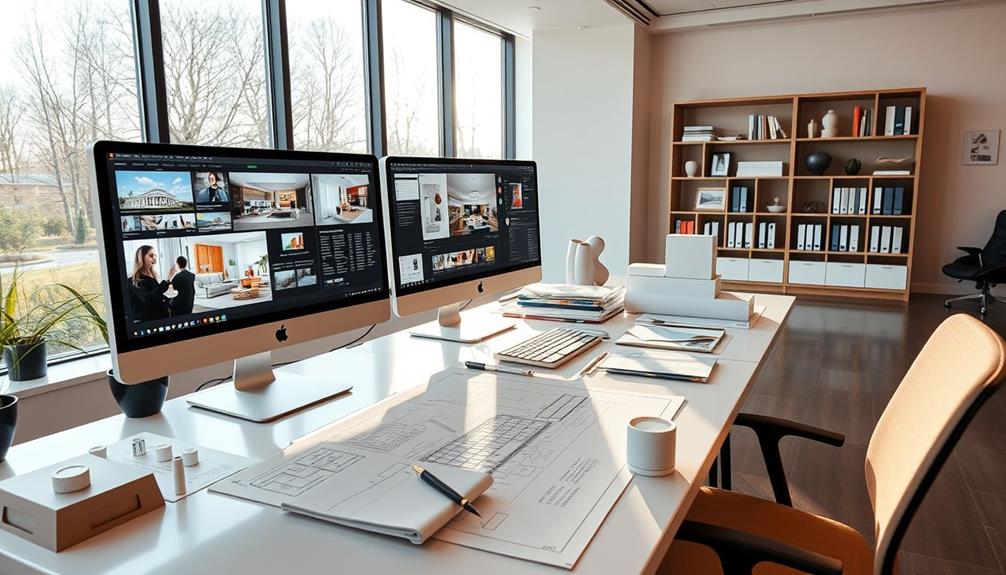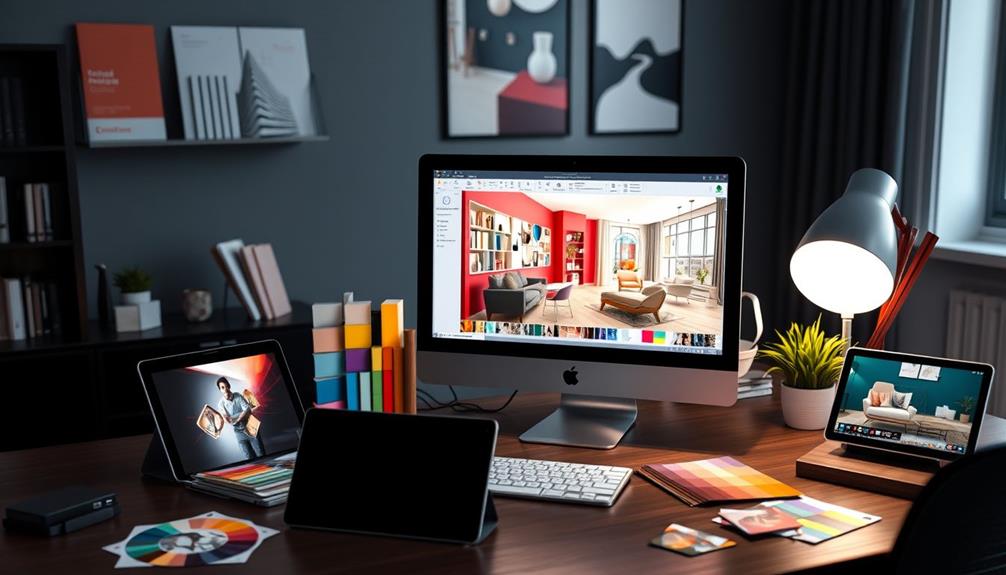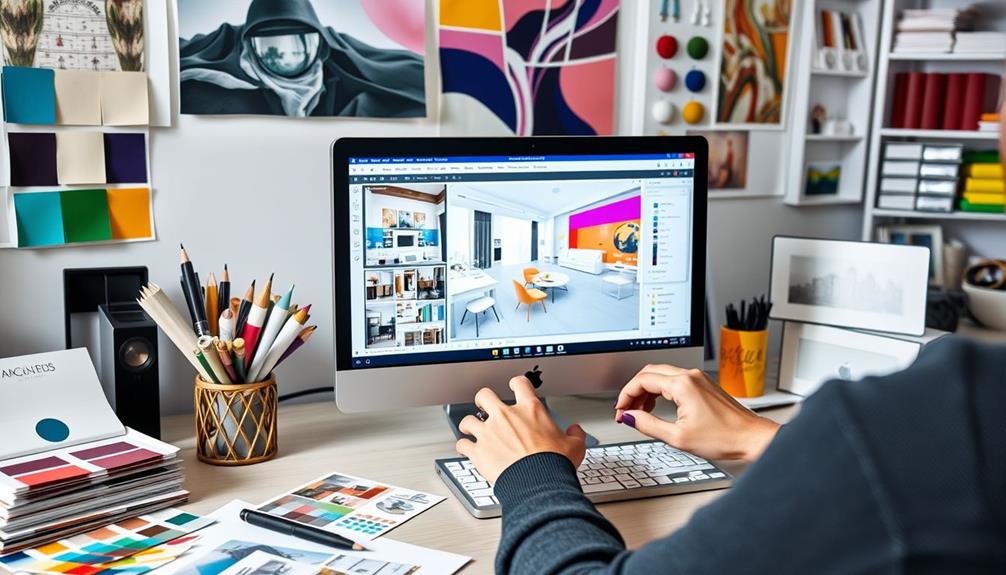To learn interior design software, start with user-friendly tools like SketchUp or RoomSketcher. These platforms let you visualize your ideas in 2D and 3D. You can find many online tutorials and courses on sites like Udemy or LinkedIn Learning that cater to all skill levels. Engage with design communities on platforms like Reddit, where you can share tips and troubleshoot. Don't forget to practice by using free or trial versions of professional software like AutoCAD or Revit, enhancing your skills without a significant cost. Keep exploring resources to fully reveal your potential in design software.
Key Takeaways
- Start with beginner-friendly tools like SketchUp and RoomSketcher to build foundational skills without overwhelming complexity.
- Utilize online courses and video tutorials on platforms like Udemy and Coursera for structured learning and practical projects.
- Engage in design communities and forums for troubleshooting tips, mentorship, and sharing experiences with other users.
- Experiment with free trials or lower-cost software versions to assess compatibility and features before committing financially.
- Stay updated with design trends and software advancements through blogs, webinars, and professional organizations to enhance your skills continuously.
Understanding Interior Design Software

Understanding interior design software is important for anyone looking to create stunning spaces, whether you're a professional or a hobbyist. These tools enable you to visualize your ideas through 2D and 3D design capabilities, making it easier to experiment with decor and layout.
Popular design software like AutoCAD, Revit, and SketchUp offer thorough tools for drafting, modeling, and rendering, allowing you to create detailed project representations.
While the learning curve can feel intimidating at first, many programs, such as Foyr Neo and RoomSketcher, come with user-friendly interfaces that facilitate quick adaptation. This user-friendliness is essential, especially if you're just starting out or if you're an experienced designer looking to enhance your skills.
For those seeking photorealistic visualizations, advanced software like 3DS Max and VRay is critical, particularly for impressing clients and solidifying design proposals.
Continuous education through online courses and tutorials is key to mastering these programs, as proficiency in multiple design software greatly boosts your job prospects in the competitive market.
Embrace the opportunity to learn, and you'll find that understanding interior design software opens up a world of creative possibilities.
Essential Software for Beginners

When you're just starting out in interior design, choosing the right software can make all the difference in your learning experience. For beginners, user-friendly design software like SketchUp and RoomSketcher is a great choice. These platforms offer intuitive interfaces and tutorials that help you learn interior design quickly and execute projects efficiently.
If you're looking for free options, Homestyler and Planner 5D provide accessible ways to practice basic software skills without any financial commitment. These tools allow you to experiment with layouts and designs at your own pace.
To enhance your understanding further, consider enrolling in courses focused on popular software like AutoCAD and SketchUp. These programs typically emphasize practical applications and can help you grasp essential concepts in just a few weeks.
Don't forget to utilize online resources, including video tutorials and forums, where you can troubleshoot common issues and learn from experienced users in the design community.
Advanced Tools for Professionals

As you advance in your interior design career, mastering software training resources becomes essential for enhancing your skills.
Tools for collaboration and integration, like Ivy or MyDoma Designer Logic, can streamline your workflow and improve teamwork.
Let's explore how these advanced tools can elevate your design projects and client presentations.
Software Training Resources
Mastering advanced interior design software requires a strategic approach to training resources that cater to professionals. Start by enrolling in formal courses focused on specific programs like AutoCAD, Revit, or SketchUp. These courses usually last about nine weeks and explore advanced techniques and best practices.
You can also utilize online platforms like LinkedIn Learning, Udemy, or Skillshare, which offer tutorials and advanced training on professional design tools, letting you learn new software at your own pace.
Participate in webinars and workshops hosted by software developers or industry organizations. These sessions provide valuable insights into new features and advanced functionalities that can enhance your work.
Additionally, joining design forums and communities like Behance or The Interior Design Community can be incredibly beneficial. Here, you can share tips, resources, and project experiences with fellow professionals.
Take advantage of free trials or student versions of the software you want to master. This hands-on experience allows you to practice advanced features without any financial commitment.
Collaboration and Integration Tools
Effective collaboration and integration tools are essential for interior design professionals looking to enhance their workflow and communication. Utilizing project management software like BaseCamp and Ivy/Houzz helps you streamline collaboration among team members, ensuring everyone is aligned throughout the design process.
Explore the integration capabilities of tools like Revit and AutoCAD with visualization software such as Enscape and VRay. This not only improves real-time rendering but also elevates your client presentations.
Familiarizing yourself with mood board software like Morpholio and Canva allows for collaborative brainstorming and easy sharing of design concepts with clients and colleagues.
You should also consider all-encompassing platforms like MyDoma Designer Logic, which combine project management features with design tools, facilitating efficient workflow management from concept to execution.
Participating in online forums or professional groups focused on software integration can also enhance your skills. Here, you can exchange best practices and tips for improving collaboration in your design projects.
Key Features to Consider

When you're picking interior design software, start by looking for a user-friendly interface that makes navigation easy.
You'll also want to check for integration capabilities with other tools you use, which can streamline your workflow.
User-Friendly Interface
Choosing the right interior design software often hinges on its user-friendly interface, which can make a world of difference in your learning experience. You'll want software that prioritizes ease of use, allowing you to navigate its features without feeling overwhelmed.
Look for programs that offer extensive tutorials and support resources; these can greatly reduce your learning curve, making it easier to adapt.
When reviewing software tools, consider those that allow you to export designs in various formats. This versatility guarantees your work integrates smoothly with other applications in your design workflow.
Additionally, assess the software's compatibility with your existing hardware to avoid unexpected costs—high-performance rendering may require advanced components that you mightn't have.
Don't forget to explore free or lower-cost versions before committing to a purchase. Testing the user-friendly interface and features firsthand will give you confidence that the software meets your design needs.
Integration Capabilities
A robust integration capability can greatly enhance your interior design workflow. When selecting interior design software, it's vital to assess how well it integrates with your existing tools and platforms. Seamless compatibility can greatly boost project efficiency and collaboration among design firms.
Look for software that supports diverse file exports, making it easy to share your designs with clients and collaborators across various applications.
Real-time collaboration features are also important; they allow multiple users to work on projects simultaneously, enhancing client-designer interactions. This capability can transform how you communicate and iterate on designs, leading to faster decision-making and improved outcomes.
Moreover, consider the availability of extensive material and asset libraries within the software. These resources can streamline your design process, offering a diverse range of options at your fingertips.
Finally, prioritize software that features a user-friendly interface and thorough training resources. This guarantees that you can quickly adapt to and master the integration capabilities, making your shift to new software as smooth as possible.
Cost and Accessibility
Cost and accessibility play essential roles in selecting the right interior design software. When considering your options, it's vital to evaluate your budget, as software prices can vary widely. Some programs may require annual subscriptions that exceed $1,700, while others offer free versions or lower-cost alternatives. To help you navigate your choices, here's a comparison of key features:
| Software Name | Cost | Accessibility Features |
|---|---|---|
| Software A | $1,200/year | Free trial, extensive tutorials |
| Software B | Free version | Strong community support |
| Software C | $700 one-time fee | Basic training resources |
| Software D | $1,500/year | thorough customer support |
| Software E | $300 one-time fee | User-friendly interface |
Ensure that the software you choose is compatible with your existing hardware, as advanced options may require upgrades. Prioritize programs that offer robust training resources, including tutorials and customer support, to ease your learning curve. By evaluating cost and accessibility, you'll be better equipped to make an informed decision tailored to your design needs.
Budgeting for Software Costs

When planning your budget for interior design software, it's vital to account for both one-time purchase costs and ongoing subscription fees. These software costs can vary considerably—while basic tools might start as low as $5 per month, industry-standard options like AutoCAD can set you back around $1,775 per year.
Additionally, consider exploring unique cultural experiences that might inspire your design aesthetics or inform your software choices. Be sure to factor in potential additional expenses for hardware upgrades, as high-quality software often requires advanced components like high RAM and robust graphics cards to run effectively.
To avoid overspending, take advantage of free trials offered by many software providers. These trials allow you to assess the software's suitability without committing to a purchase, helping you steer clear of unnecessary costs.
Budgeting for future software needs is also important. Treat your investment as a long-term commitment, ensuring your budget accommodates potential price increases or subscription renewals.
If you're just starting out, consider free or lower-cost options like SketchUp or Planner 5D. These tools provide vital functionalities without straining your budget, making them perfect for beginners and small firms enthusiastic to make their mark in interior design.
Learning Resources and Tutorials

When you start learning interior design software, you'll find a wealth of resources at your fingertips.
Online courses can provide structured guidance, while video tutorials on platforms like YouTube offer visual step-by-step instructions.
Engaging with community forums can also enhance your learning experience by connecting you with fellow users who share tips and insights.
Online Courses Availability
With a wealth of online courses available, you can easily immerse yourself in learning interior design software like AutoCAD and SketchUp. These courses cater to all skill levels, ensuring that you can find the right fit whether you're a beginner or looking to refine your expertise. Platforms like Coursera and Udemy offer targeted courses that include practical projects, helping you apply what you learn in real-world scenarios.
Here's a quick overview of some popular online course options:
| Course Provider | Key Features |
|---|---|
| Coursera | Specializations, peer reviews |
| Udemy | Wide range of topics, lifetime access |
| LinkedIn Learning | Industry-focused, certification options |
Beyond these platforms, free resources like YouTube tutorials and design forums can supplement your learning. They offer valuable insights and troubleshooting support from fellow users. Additionally, many online programs feature interactive elements like live webinars and Q&A sessions with industry professionals. These opportunities enhance your engagement and understanding of the latest trends in interior design software. With these learning resources at your fingertips, you'll be well-equipped to excel in your design journey.
Video Tutorials Access
Accessing video tutorials is a fantastic way to enhance your skills in interior design software. Many platforms, like SketchUp and AutoCAD, offer official video tutorials on their websites, helping you familiarize yourself with essential tools and features.
YouTube also hosts a treasure trove of user-generated video tutorials, covering everything from basic functions to advanced techniques in popular software like Revit and 3DS Max. For those interested in creating immersive presentations, consider exploring home theater setup essentials to enhance your design showcases.
If you prefer structured learning, platforms like LinkedIn Learning and Udemy provide extensive courses specifically designed for software for interior designers. These courses can guide you through the design process step by step, ensuring you grasp the key concepts effectively.
Moreover, tools like Foyr Neo include built-in tutorials and guided walkthroughs, facilitating real-time learning as you navigate the program. By engaging with these video tutorials, you can quickly overcome common challenges and refine your skills.
Don't forget to explore online communities where experienced users often share valuable video resources and tips. These insights can enhance your understanding and help you apply what you've learned effectively in your design projects.
Community Forums Engagement
Engaging in community forums can greatly enhance your learning experience with interior design software. By participating in platforms like Reddit, Houzz, or Design Inspirations, you gain access to a wealth of insights from experienced designers and peers.
These community forums offer you the chance to ask questions, receive feedback, and share your own knowledge, creating a collaborative environment that can greatly boost your mastering of any design app.
Many software-specific groups, such as those for AutoCAD or SketchUp, provide dedicated tutorials and troubleshooting advice, making it easier to overcome challenges.
Additionally, participating in webinars and online workshops gives you hands-on training from experts, enriching your learning experiences further.
Don't overlook the power of platforms like YouTube, where countless tutorials are available to help you understand software functionalities at your own pace.
Finally, by joining social media groups focused on interior design software, you can stay up-to-date on new features, best practices, and emerging trends in design technology.
Engaging in these forums not only enhances your skills but also connects you with a community of like-minded individuals passionate about interior design.
Communities and Networking Opportunities

Regularly participating in design communities can greatly enhance your learning experience with interior design software. By joining groups on platforms like LinkedIn or Facebook, you access a treasure trove of resources, including tutorials and webinars that explore best practices.
These communities foster discussions that can deepen your understanding of design principles and software functionalities. Networking events, such as those organized by the American Society of Interior Designers (ASID), offer the chance to meet experienced professionals. They can provide invaluable guidance and mentorship, particularly in mastering software tools.
Engaging in forums like Reddit's r/interiordesign or specialized software communities is another way to share your experiences and troubleshoot challenges. Additionally, attending industry conferences and workshops often includes hands-on sessions with leading software, allowing you to learn practically while connecting with others in the field.
Collaborating on projects through platforms like Houzz Pro not only hones your software skills but also helps you build a portfolio. You'll receive feedback from peers and clients, further enriching your design journey. Embrace these opportunities, and you'll find your proficiency in interior design software growing exponentially.
Hands-On Practice Techniques

While diving into interior design software, hands-on practice is essential for mastering its features and tools. One effective approach is engaging in project-based learning. Create real or fictional design projects using modeling software like SketchUp or AutoCAD. This allows you to apply concepts and tools in a practical context, reinforcing your skills.
Utilize online tutorials and resources tailored to the software you're learning. Platforms like YouTube and LinkedIn Learning offer step-by-step guidance on effectively using various features. Don't shy away from experimenting with different tools to learn. For instance, play with rendering options in 3Ds Max or adjust lighting effects in SketchUp to understand their functions better.
Joining design forums or social media groups focused on your chosen software can also enhance your learning experience. Share your work, ask questions, and seek constructive feedback from experienced users and peers.
Staying Updated With Trends

Staying updated with trends in interior design software is essential for any designer aiming to remain competitive. To do this effectively, regularly follow design blogs, industry publications, and social media channels. These platforms are great sources for the latest software updates and emerging trends in the design industry.
Participating in webinars and online courses can also deepen your understanding of new features and techniques within popular software. This not only enhances your skills but also keeps you informed about the tools that can elevate your design projects.
Joining professional organizations like ASID or local design groups is another excellent way to network with fellow designers. You'll gain valuable insights into current trends and effective software utilization from experienced peers.
Don't forget to subscribe to newsletters and publications that focus on technological advancements in design software; they provide timely updates and expert opinions.
Building a Portfolio With Software

Building a strong portfolio with interior design software is essential for showcasing your skills and attracting potential clients. To effectively build your portfolio, consider these key steps:
- Diverse Projects: Use various interior design software like SketchUp for 3D modeling and AutoCAD for detailed floor plans, highlighting your versatility.
- High-Quality Visualizations: Incorporate stunning renderings from tools like 3DS Max or Enscape to demonstrate your ability to create photorealistic images that captivate clients.
- Detailed Documentation: For each project, include clear descriptions of your design process, the software used, and challenges you faced, showcasing your problem-solving skills.
- Before-and-After Comparisons: Show iterations of your designs to illustrate how you adapt concepts based on client feedback, emphasizing your responsiveness.
Regularly updating your portfolio with new projects and software proficiencies helps reflect current trends and your growing expertise.
Conclusion
Learning interior design software is like planting a garden; it takes time, patience, and the right tools to flourish. Just as a gardener carefully selects seeds and nurtures them, you'll choose software that fits your style and needs. With practice and community support, your skills will bloom, creating vibrant spaces that reflect your vision. Remember, every design journey begins with a single project—so dig in, experiment, and watch your creativity grow!







